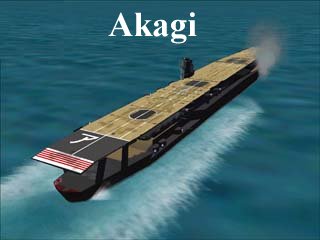
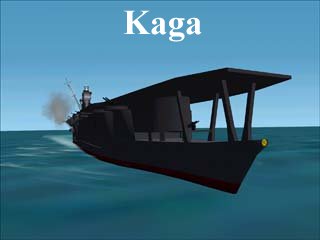

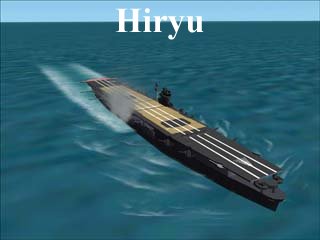




Akagi was laid in December, 1920, originally as battle cruiser,
however, she was converted to the Aircraft Carrier as a result
of the 1922 Washington Treaty. She was named after the name
of volcano Akagi in the Kanto area.
Her sister ship, Amagi, was also in the process of conversion
to the carrier, however, she was heavily damaged by the Kanto
earthquake and fire in September, 1923. The project of Amagi
to convert the carrier was abandoned, and as a consequence,
Kaga had replaced Amagi in the project.
In the Midway operations, she was heavily damaged with the
bombs dropped by the US Dive Bomber and was immobilized.
She was finally disposed of by the torpedos launched by the
IJN destroyers.
Technical Data
| Displacement | 36,500 t |
| Length | 260,7 m |
| Width | 31,3 m |
| Maximum Speed | 31.2 kt |
| Aircraft | Normal accommodation for 66 planes, plus 25 more capacity. |
Kaga was laid down originally as a battleship, however, she was
due to be scrapped under the terms of the 1922 Washington
Treaty. Due to loss of Amagi by earthquake in 1923, Kaga
replaced Amagi and was converted to the aircraft carrier.
She was named after the name of a province Kaga, now a
part of Ishikawa prefecture.
In the Midway operations, she engaged and was attacked by
numerous enemy land and carrier-borne aircraft. She was
struck by four or more number of bombs of the US Dive
Bombers, resulted fatal explosion and was sunk.
Technical Data
| Displacement | 38,200 t |
| Length | 248,6 m |
| Width | 32,5 m |
| Maximum Speed | 28,3 kt |
| Aircraft | Normal accommodation for 72 planes, plus 18 more capacity. |
The Imperial Japanese Navy had an object to construct
Two Aircraft Carriers within the limit imposed by the 1922
Washinton Treaty. The first one was launched from the
shipbuilding yard in September, 1937, and she was named
SOURYU, which means bluish dragon in English.
Souryu was made from the beginning as an aicraft carrier
of the IJN for the first time. The appearance of Souryu
was, therefore, given to what looked at sense of stability
compared with Akagi and Kaga, which were converted to
the carriers from the cruiser and the battleships.
Souryu participated in the Battle of Midway, to launch
strike against Midway Island. However, while preparing to
launch strike against enemy carrier, she was attacked by
numerous enemy dive bombers. Three bombs hit the carrier,
resulted explosions of the ammunition dump under the deck.
She begun to sink by the stern and a few minutes later
upended and sunk. Captain of the ship, R. Yanagimoto
remained aboard at his will.
Technical Data
| Displacement | 15,900 t |
| Length | 227,5 m |
| Width | 21,3 m |
| Maximum Speed | 34,5 kt |
| Aircraft | Normal accommodation for 57 planes, plus 16 more capacity. |
Hiryu participated in the Battle of Midway, together with
other Carriers. Only the Hiryu remained after the IJN
left three other carriers dead in the water.
The Captain of Hiryu, Admiral T. Yamaguchi launched
an immediate counterstrike. Within an hour or so, planes
from the Hiryu were over the Yorktown. The first and
second strikes from the Hiryu gave a fatal damage to
the Yorktown. While the Yorktown was being attacked,
the Hiryu herself was pounced on by dive bombers from
the Enterprise. The American planes pounded the Hiryu
with four quick bomb hits. Admiral Yamaguchi went down
with his ship, despite the pleas of his fellow officers.
Technical Data
| Displacement | 17,300 t |
| Length | 237.35 m |
| Width | 22,3 m |
| Maximum Speed | 34,59 kt |
| Aircraft | Normal accommodation for 57 planes, plus 16 more capacity. |
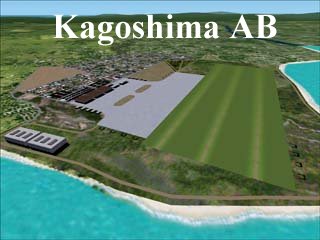
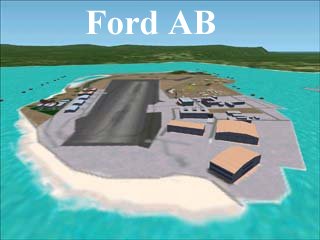
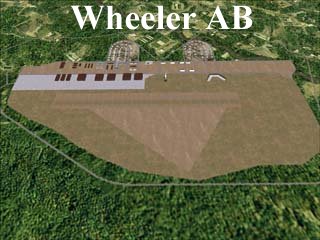
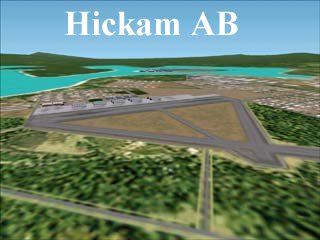
To select one of four Air Bases in Free Flight, 1. Go to Free Flight, and press the Start Location... bar, to 2. go to GO TO LOCATION window, then press the Advanced Go To... bar, to 3. go to ADVANCED GO TO window, then click the radio button for scenery from FS95 and before. You'll see the name of four Air Bases under Senery areas.Back